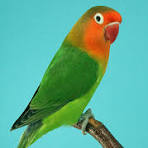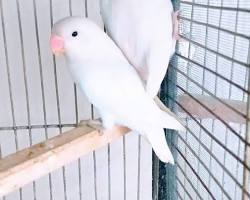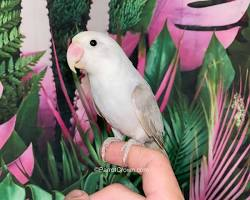Green Fischer's Lovebird: Urdu text after English info
A vibrant and curious
companion, and best foster parents
Asher Butt
The Fischer's lovebird, slightly less common than its
peach-faced cousin, is a vibrant and engaging pet. Originating from Central
Africa, specifically areas like Tanzania and the Rift Valley, these small
parrots were first documented by German explorer Gustav Fischer. They've been
popular in the pet trade since the 1920s.
Personality: Fischer's lovebirds are known for their
inquisitive and active nature. They're constantly on the move, exploring their
surroundings, making them entertaining to watch. Like other lovebirds, they
typically mate for life, forming strong bonds with their partners. A single
bird needs plenty of attention and enrichment to prevent boredom and potential
behavioral issues like feather plucking or territorial aggression.
Vocalization: Fischer's lovebirds are vocal, filling
the day with chirps, whistles, and a pleasant, low-volume chatter. They are
most active vocally at dawn and dusk. While they communicate extensively with
each other, they don't mimic human speech. The more birds you have, the louder
the overall noise level will be.
Appearance: These small parrots, reaching only about
6 inches in length, are brightly colored. They have a distinctive orange head,
a green body, a red beak, and white rings around their eyes. Some may also have
yellow coloring where the orange and green meet, or green highlights on their
face. Both males and females look identical (monomorphic).
Care Requirements:
- Housing:
A single Fischer's lovebird needs a cage at least 18x18x18 inches. A pair
requires a minimum of 24x18x24 inches. The bigger the cage, the better.
The cage should include soft wooden toys for chewing, and perches of
varying sizes for their comfort. Daily supervised time outside the cage is
essential for exercise and mental stimulation.
- Diet:
A high-quality seed mix forms the base of their diet. Supplement this with
small amounts of fruits and vegetables. Commercial lovebird food mixes are
readily available and convenient. Offer small pieces of apple or other
suitable fruits as a weekly treat. Avoid avocado and chocolate, as they
are toxic to birds.
- Exercise:
Fischer's lovebirds are very active and require several hours of
supervised flight time outside their cage each day. Before letting them
out, ensure the room is secure, as their curiosity can lead them into
trouble. Keep other pets out of the room during these outings to avoid
stressing the bird.
- Health:
Single Fischer's lovebirds can be prone to anxiety, which can manifest as
feather plucking. Providing a companion bird, more attention, and ample
out-of-cage time can help alleviate this. Other common health issues
include psittacine beak and feather disease, yeast infections, avian pox,
internal and external parasites, bacterial and viral infections, and
respiratory problems. Regular vet checkups are recommended.
Foster Parenting: Interestingly, Fischer's lovebirds
are sometimes used as foster parents for other small parrot species. Their
gentle nature and parenting instincts make them suitable for raising chicks of
similar size and temperament. This practice is particularly useful for breeding
rare or endangered species, where maximizing chick survival rates is crucial.
Breeders often use Fischer's lovebirds to ensure that chicks receive proper
parental care, even if the biological parents are unable or unwilling to
provide it.
Purchasing: Fischer's lovebirds are relatively easy
to find at pet stores. However, consider adopting from a local animal shelter
or rescue organization. Adopting often costs less and provides a home for a
bird in need.
Lifespan: With proper care, Fischer's lovebirds can
live for 15-20 years, and sometimes even longer.
Color Mutations: Several color mutations exist,
including Lutino (yellow), Blue, Albino, Dark-eyed White, Cinnamon, and Dilute
Yellow.
Fischer's lovebirds, like many other bird species, have
undergone several mutations that have resulted in a variety of beautiful color
variations. Here are some of the most common mutations produced from the green
Fischer's lovebird:
- Lutino:
This is one of the most popular mutations. The green plumage is replaced
by bright yellow, and the bird retains its orange face and red beak.
Lutino Fischer's lovebird
- Blue:
This mutation removes the yellow pigment, resulting in a stunning blue
bird with a white face and a pale pink beak.
Blue Fischer's lovebird
- Albino:
This is a double recessive mutation that results in a completely white
bird with red eyes.
Albino Fischer's lovebird
- Dark-eyed
White: This mutation is similar to albino, but the bird retains its
dark eyes.
Darkeyed White Fischer's lovebird
- Cinnamon:
This mutation affects the melanin pigment, resulting in a lighter brown
color on the bird's feathers.
Cinnamon Fischer's lovebird
- Dilute
Yellow: This mutation dilutes the yellow pigment, resulting in a paler
yellow bird.
These are just a few of the many mutations that have been
produced from the green Fischer's lovebird. Each mutation is unique and
beautiful, and they all contribute to the diversity of this fascinating
species.
Social Behavior: Fischer's lovebirds thrive in pairs.
They are known for their strong pair bonds and are happiest when they have a
companion. A single bird requires significantly more attention from its owner.
Grooming: Fischer's lovebirds enjoy bathing. Provide
them with a shallow dish of water or gently mist them with lukewarm water. They
also naturally keep their beaks and nails trimmed by chewing on wooden perches
and toys.
Price: A pair of Fischer's lovebirds typically costs
between $100 and $150.
سبز فشر
لو برڈ: ایک متحرک اور تجسس پسند ساتھی، اور بہترین رضاعی والدین
فشر لو
برڈ، اپنے پیچ فیسڈ کزن سے قدرے کم عام، ایک متحرک اور دلکش پالتو جانور ہے۔ وسطی
افریقہ، خاص طور پر تنزانیہ اور رفٹ ویلی جیسے علاقوں سے تعلق رکھنے والے یہ چھوٹے
طوطے پہلی بار جرمن ایکسپلورر گستاو فشر نے دریافت کیے تھے۔ وہ 1920 کی دہائی سے
پالتو جانوروں کی تجارت میں مقبول ہیں۔
شخصیت: فشر لو
برڈ اپنی تجسس پسند اور فعال فطرت کے لیے جانے جاتے ہیں۔ وہ مسلسل حرکت میں رہتے
ہیں، اپنے ماحول کو دریافت کرتے ہیں، جس سے وہ دیکھنے میں دل لگی بن جاتے ہیں۔
دوسرے لو برڈز کی طرح، وہ عام طور پر زندگی بھر کے لیے جوڑا بناتے ہیں، اپنے
ساتھیوں کے ساتھ مضبوط بندھن بناتے ہیں۔ ایک اکیلے پرندے کو بوریت اور ممکنہ رویے
کے مسائل جیسے پر کُترنا یا علاقائی جارحیت کو روکنے کے لیے بہت زیادہ توجہ اور
افزودگی کی ضرورت ہوتی ہے۔
آوازیں: فشر لو
برڈ بہت بولنے والے ہوتے ہیں، جو دن بھر چہچہوں، سیٹیوں اور ایک خوشگوار، کم حجم
کی چہچہاٹ سے بھر دیتے ہیں۔ وہ طلوع فجر اور شام کے وقت سب سے زیادہ متحرک ہوتے
ہیں۔ اگرچہ وہ ایک دوسرے کے ساتھ بڑے پیمانے پر بات چیت کرتے ہیں، لیکن وہ انسانی
تقریر کی نقل نہیں کرتے ہیں۔ آپ کے پاس جتنے زیادہ پرندے ہوں گے، مجموعی شور کی
سطح اتنی ہی زیادہ ہوگی۔
ظاہری
شکل: یہ چھوٹے طوطے، جو صرف 6 انچ کی
لمبائی تک پہنچتے ہیں، چمکدار رنگ کے ہوتے ہیں۔ ان کا ایک مخصوص نارنجی سر، ایک
سبز جسم، ایک سرخ چونچ اور ان کی آنکھوں کے گرد سفید حلقے ہوتے ہیں۔ کچھ میں پیلا
رنگ بھی ہو سکتا ہے جہاں نارنجی اور سبز ملتے ہیں، یا ان کے چہرے پر سبز نمایاں
نشانات ہو سکتے ہیں۔ نر اور مادہ دونوں ایک جیسے نظر آتے ہیں (مونومورفک)۔
دیکھ
بھال کی ضروریات:
- رہائش: ایک اکیلے فشر لو برڈ کے لیے کم از کم 18x18x18 انچ کا پنجرا درکار ہوتا ہے۔ ایک جوڑے
کے لیے کم از کم 24x18x24 انچ کی ضرورت ہوتی ہے۔ پنجرا جتنا بڑا
ہوگا، اتنا ہی بہتر ہے۔ پنجرے میں چبانے کے لیے نرم لکڑی کے کھلونے، اور
مختلف سائز کے پرچ شامل ہونے چاہئیں تاکہ ان کی سہولت ہو۔ ورزش اور ذہنی
تحریک کے لیے پنجرے سے باہر روزانہ نگرانی کا وقت ضروری ہے۔
- خوراک: اعلیٰ معیار کا بیج مکس ان کی خوراک کی
بنیاد بناتا ہے۔ اس میں پھلوں اور سبزیوں کی تھوڑی مقدار شامل کریں۔ تجارتی
لو برڈ فوڈ مکس آسانی سے دستیاب اور آسان ہیں۔ ہفتے میں ایک بار سیب یا دیگر
مناسب پھلوں کے چھوٹے ٹکڑے بطور دعوت دیں۔ ایوکاڈو اور چاکلیٹ سے پرہیز کریں،
کیونکہ وہ پرندوں کے لیے زہریلے ہیں۔
- ورزش: فشر لو برڈ بہت فعال ہوتے ہیں اور انہیں ہر
روز پنجرے سے باہر کئی گھنٹے نگرانی میں پرواز کے وقت کی ضرورت ہوتی ہے۔
انہیں باہر جانے دینے سے پہلے، یقینی بنائیں کہ کمرہ محفوظ ہے، کیونکہ ان کی
تجسس انہیں مشکل میں ڈال سکتی ہے۔ ان کے باہر جانے کے دوران دوسرے پالتو
جانوروں کو کمرے سے باہر رکھیں تاکہ پرندے پر دباؤ نہ پڑے۔
- صحت: اکیلے فشر لو برڈ اضطراب کا شکار ہو سکتے
ہیں، جو پر کُترنے کی صورت میں ظاہر ہو سکتا ہے۔ ایک ساتھی پرندہ، زیادہ
توجہ، اور پنجرے سے باہر کافی وقت فراہم کرنے سے اسے کم کرنے میں مدد مل سکتی
ہے۔ دیگر عام صحت کے مسائل میں سائٹاسین چونچ اور پنکھ کی بیماری، خمیر کی
انفیکشن، ایویئن پاکس، اندرونی اور بیرونی پرجیوی، بیکٹیریل اور وائرل
انفیکشن، اور سانس کے مسائل شامل ہیں۔ باقاعدگی سے جانوروں کے ڈاکٹر سے چیک
اپ کروانے کی سفارش کی جاتی ہے۔
رضاعی
والدین: دلچسپ بات یہ ہے کہ فشر لو برڈ عام
طور پر دیگر چھوٹے طوطے کی اقسام کے لیے رضاعی والدین کے طور پر استعمال ہوتے ہیں۔
ان کی نرم فطرت اور والدینت کے جبلت انہیں ملتے جلتے سائز اور مزاج کے چوزے پالنے
کے لیے موزوں بناتے ہیں۔ یہ عمل خاص طور پر نایاب یا خطرے سے دوچار اقسام کی
افزائش کے لیے مفید ہے، جہاں چوزے کی بقا کی شرح کو زیادہ سے زیادہ کرنا بہت ضروری
ہے۔ بریڈر اکثر فشر لو برڈ استعمال کرتے ہیں تاکہ یہ یقینی بنایا جا سکے کہ چوزے
مناسب والدینت کی دیکھ بھال حاصل کریں، یہاں تک کہ اگر حیاتیاتی والدین فراہم کرنے
سے قاصر یا ناپسند ہوں۔
خریداری: فشر لو
برڈ پالتو جانوروں کی دکانوں پر نسبتاً آسانی سے مل جاتے ہیں۔ تاہم، مقامی جانوروں
کی پناہ گاہ یا بچاؤ تنظیم سے گود لینے پر غور کریں۔ گود لینے میں اکثر کم خرچ آتا
ہے اور ایک ایسے پرندے کو گھر مل جاتا ہے جسے ضرورت ہے۔
عمر: مناسب
دیکھ بھال کے ساتھ، فشر لو برڈ 15-20 سال تک، اور کبھی کبھی اس سے بھی زیادہ زندہ
رہ سکتے ہیں۔
رنگ کی
تبدیلیاں: کئی رنگ کی تبدیلیاں موجود ہیں،
بشمول لوٹینو (پیلا)، نیلا، البینو، ڈارک آئیڈ وائٹ، دار چینی، اور ڈیلٹ پیلا۔
مختلف
تبدیلیاں پیدا کرنا: فشر لو برڈ، دوسرے پرندوں کی طرح،
کئی تبدیلیاں سے گزرے ہیں جس کے نتیجے میں خوبصورت رنگ کی مختلف حالتیں پیدا ہوئی
ہیں۔ وہ نئے تغیر کی بنیادی ڈیولپر کے طور پر تیار کرنے میں مدد کرتے ہیں جیسے
پاربلیو، جو مزید تغیرات پیدا کرنے میں مدد کرتا ہے۔ سبز فشر لو برڈ سے پیدا ہونے
والی کچھ عام تبدیلیاں یہ ہیں:
- لوٹینو: یہ سب سے مقبول تبدیلیوں میں سے ایک ہے۔
سبز پنکھ پیلے رنگ سے بدل جاتا ہے، اور پرندہ اپنا نارنجی چہرہ اور سرخ چونچ
برقرار رکھتا ہے۔
- نیلا: یہ تبدیلی پیلے رنگ کو ختم کر دیتی ہے، جس
کے نتیجے میں ہلکے سرمئی پیشانی اور ہلکے گلابی چونچ کے ساتھ ایک شاندار نیلا
پرندہ بنتا ہے۔
- البینو: یہ ایک ڈبل ریسیسیو تبدیلی ہے جس کے نتیجے
میں سرخ آنکھوں والا مکمل طور پر سفید پرندہ بنتا ہے۔
- ڈارک آئیڈ
وائٹ: یہ
تبدیلی البینو سے ملتی جلتی ہے، لیکن پرندہ اپنی سیاہ آنکھیں برقرار رکھتا
ہے۔
- دار چینی: یہ تبدیلی میلانین رنگ کو متاثر کرتی ہے،
جس کے نتیجے میں پرندے کے پنکھوں پر ہلکا بھورا رنگ ہوتا ہے۔
- ڈیلٹ
پیلا: یہ
تبدیلی پیلے رنگ کو کم کرتی ہے، جس کے نتیجے میں ہلکا پیلا پرندہ بنتا ہے۔
یہ سبز
فشر لو برڈ سے پیدا ہونے والی بہت سی تبدیلیوں میں سے چند ایک ہیں۔ ہر تبدیلی
منفرد اور خوبصورت ہے، اور وہ سب اس دلچسپ نوع کی تنوع میں حصہ ڈالتے ہیں۔
معاشرتی
رویہ: فشر لو برڈ جوڑوں میں پروان چڑھتے
ہیں۔ وہ اپنے مضبوط جوڑے کے بندھن کے لیے جانے جاتے ہیں اور تب ہی خوش ہوتے ہیں جب
ان کے پاس کوئی ساتھی ہو۔ ایک اکیلے پرندے کو اپنے مالک سے بہت زیادہ توجہ کی
ضرورت ہوتی ہے۔
سجاوٹ: فشر لو
برڈ کو نہانا پسند ہے۔ انہیں اتھلے پانی کا ایک برتن یا ہلکے گرم پانی سے آہستہ سے
دھندلا دیں۔ وہ لکڑی کے پرچوں اور کھلونوں پر چبا کر اپنی چونچ اور ناخنوں کو بھی
قدرتی طور پر تراشتے ہیں۔
قیمت: بین
الاقوامی مارکیٹ میں فشر لو برڈ کے ایک جوڑے کی قیمت عام طور پر $100 اور $150 کے
درمیان ہوتی ہے۔






No comments:
Post a Comment